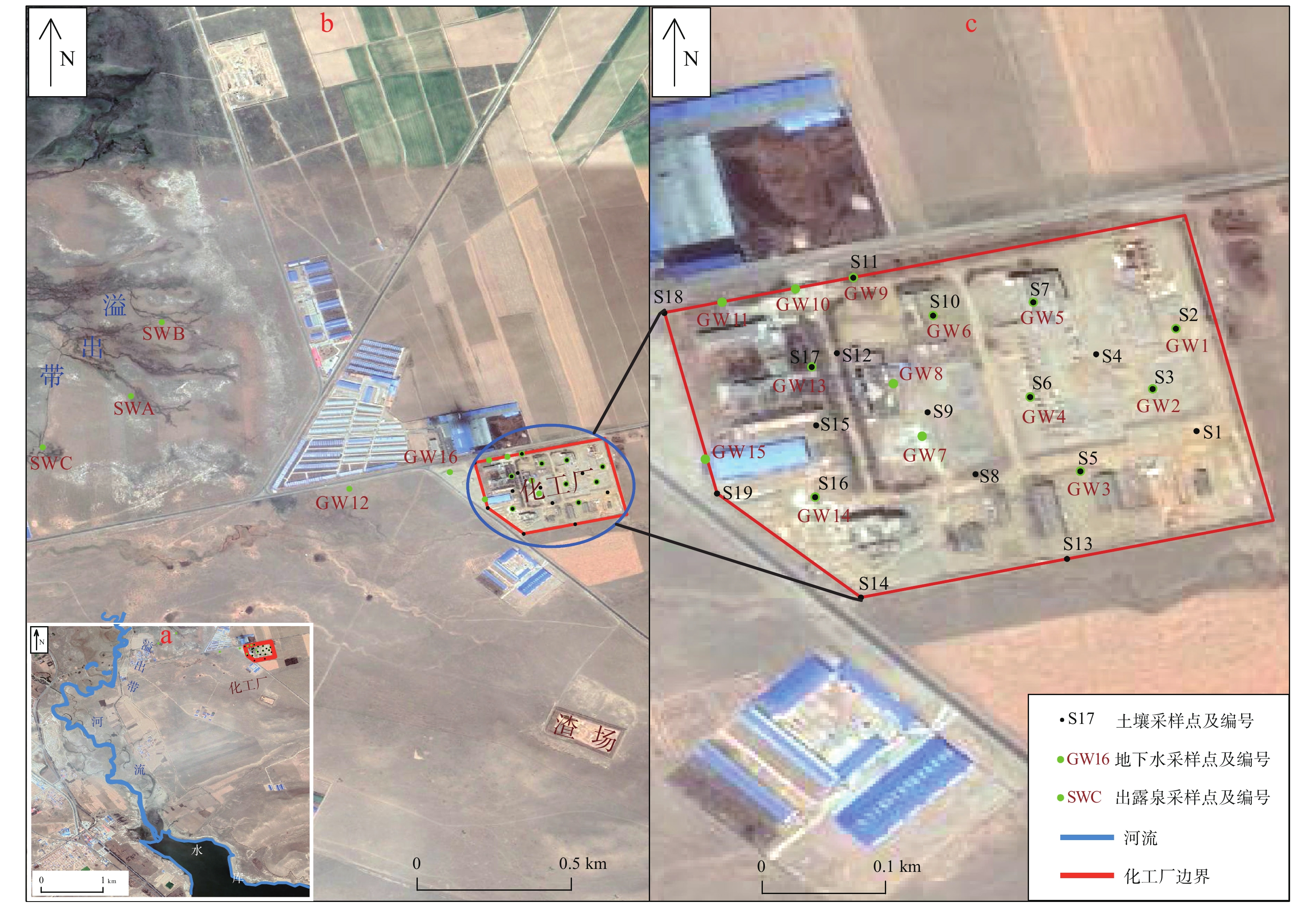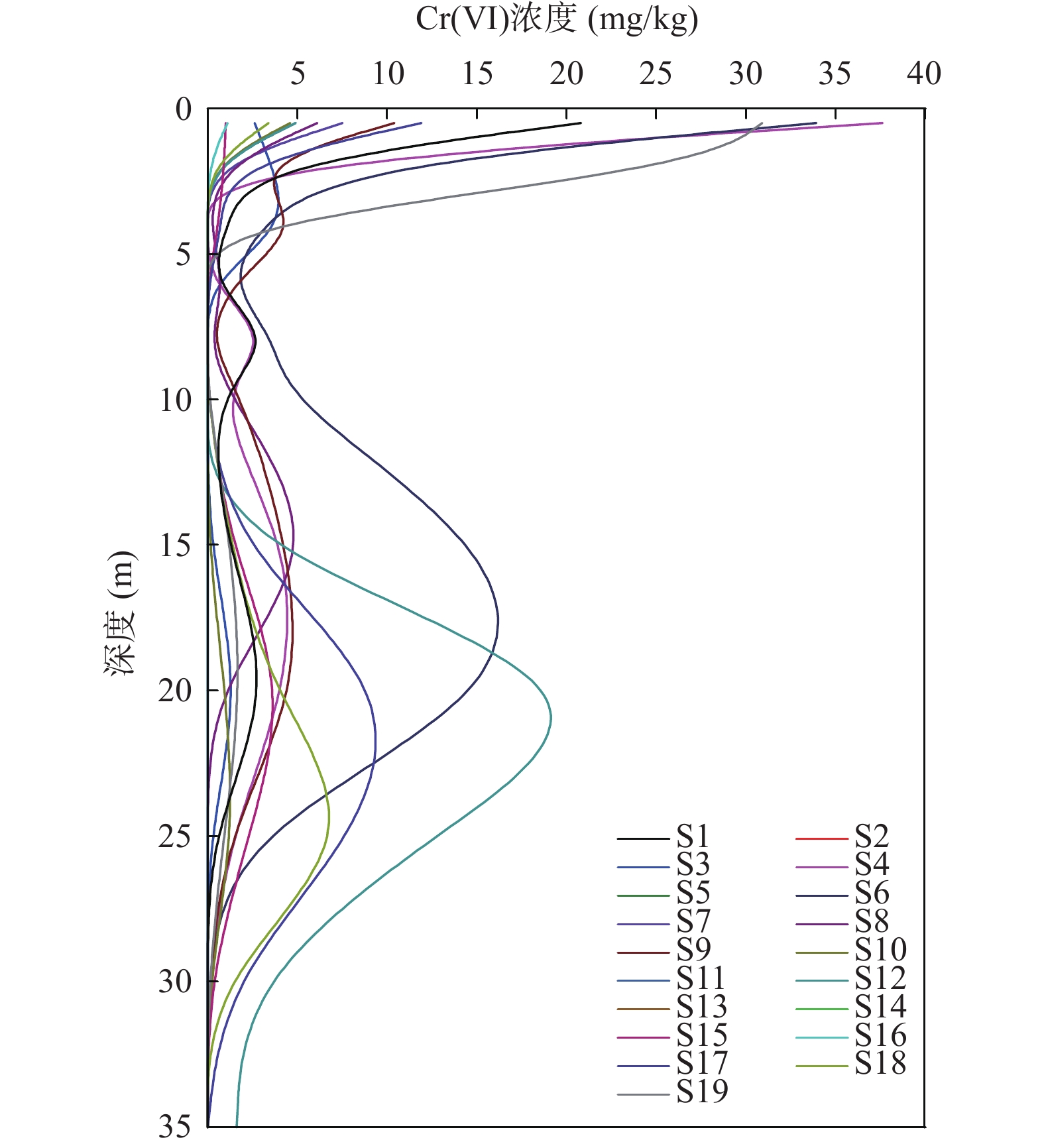Distribution and Health Risk Assessment of Cr6+ in Soil and Groundwater of a Chemical Plant
-
摘要:
为掌握某化工厂Cr6+污染状况及风险水平,在研究区布设土壤与地下水采样点各19个,测定Cr6+含量,分析污染特征与成因,并开展健康风险评估。结果表明:表层土壤(0~0.5 m)Cr6+超标率为42.11%,其浓度随深度增加总体上降低,但在地下水位附近(15~20 m)回升,主要因长期淋溶作用使污染物向下迁移至含水层位富集。浅层地下水Cr6+超标率为73.68%,深层地下水超标率为37.50%。整体而言该区土壤和地下水Cr6+污染形势不容乐观,应开展水土协同治理。空间上表层土壤Cr6+分布受人类活动影响,与投产期厂内功能区的划分相关性较低。地下水Cr6+受水动力场影响,表现为西北高东南低,污染羽中心向下游方向迁移。土壤致癌风险均值为1.85×10−6,介于10−6~10−4,风险中等,应引起必要重视。非致癌风险低于1,无慢性毒害影响。经口摄入土壤为主要暴露途径。地下水致癌风险高达10−2数量级,远超过10−4,风险不可接受。非致癌风险均值51.62,远大于1,极可能引发慢性毒害效应。另外需进一步考虑Cr6+通过牛羊肉食物链进入人体的危害。
Abstract:In order to clarify the Cr6+ pollution status and risk level of a chemical plant, 19 soil and groundwater sampling points were laid in the study area, and the content of Cr6+ was measured, to analyze the pollution characteristics and causes, and to carry out health risk assessment. The results showed that the excess rate of Cr6+ in topsoil (0~0.5 m) was 42.11%. In general, the Cr6+ concentration in soil decreased with the increase of depth, but it rose up near the groundwater level (15~20 m), which was mainly due to the long-term leaching effect that the pollutants migrated down to the aquifer and enriched. The excess rate of Cr6+ in shallow and deep groundwater was 73.68% and 37.50%, respectively. Overall, the Cr6+ pollution is not optimistic, and comprehensive water-soil treatment should be carried out. At the spatial scale the distribution of Cr6+ in topsoil was affected by human activities, and had a low correlation with the division of functional zones. And under the influence of hydrodynamic field, Cr6+ in groundwater is higher in the northwest than the southeast, and the center of the pollution plume has migrated downstream. In addition, the mean value of soil carcinogenic risk is 1.85×10−6, which is between 10−6 and 10−4, and the risk is moderate, which should be paid more attention to. Soil non-carcinogenic risk is less than 1 and doesn’t produce chronic toxic effects. Oral ingestion of soil was the main exposure route. The carcinogenic risk of groundwater is up to the order of 10−2, much more than 10−4, which is unacceptable. The average non-carcinogenic risk is 51.62, much higher than 1, which may cause chronic toxic effects. In addition, the health hazards caused by Cr6+ entering the human body through the beef and mutton food chain should be further studied.
-
Key words:
- heavy metal /
- chromium /
- pollution characteristics /
- health risk assessment
-

-
表 1 健康风险评价模型相关参数表
Table 1. Parameters of health risk assessment model
类型 参数 单位 取值 数据来源 暴露量评估 ABSd / 0.001 王珊等,2019 Rs mg/d 100 《建设用地土壤污染风险
评估技术导则》(HJ 25.3-2019)ED a 25 EF d/a 250 BW kg 61.8 ABSo / 1 AT d 致癌:27740;
非致癌:9125SSAR mg/cm2 0.2 Ev 次/d 1 H cm 161.5 SER / 0.18 PM10 mg/m3 0.119 Ra m3/d 14.5 PIAF / 0.75 fspi / 0.8 fspo / 0.5 EFi d/a 187.5 Rw L/d 1 Efo d/a 62.5 SAE cm2 765.97 公式(3)计算 毒性评估 IUR m3/mg 0.12 《建设用地土壤污染风险
评估技术导则》(HJ 25.3-2019)RfC mg/m3 0.0001 ABSgi / 0.025 风险评估 SFo [mg/(kg·d)]−1 0.5 王珊等,2019 SFd [mg/(kg·d)]−1 20 公式(10)和(12)计算 SFp [mg/(kg·d)]−1 0.51 RfDo mg/(kg·d) 0.003 《建设用地土壤污染风险
评估技术导则》(HJ 25.3-2019)RfDd mg/(kg·d) 7.50E-05 公式(11)和(13)计算 RfDp mg/(kg·d) 2.35E-05 SAF / 0.5 《建设用地土壤污染风险
评估技术导则》(HJ 25.3-2019)WAF / 0.5 表 2 土壤Cr6+污染浓度统计特征
Table 2. Statistical characteristics of Cr6+ pollution concentration in soil
深度(m) 采样数(个) 最大值(mg/kg) 最小值(mg/kg) 平均值(mg/kg) 方差 C·V 0~0.5 19 37.60 0.00 9.56 11.80 1.24 0.5~2.0 19 27.50 0.00 2.39 6.19 2.58 2.0~4.0 19 5.50 0.00 0.81 1.60 1.97 4.0~6.0 19 1.20 0.00 0.17 0.40 2.32 6.0~8.0 19 4.00 0.00 0.62 1.42 2.31 8.0~10.0 19 4.20 0.00 0.39 1.04 2.62 10.0~15.0 19 16.10 0.00 2.00 3.83 1.92 15.0~20.0 19 20.70 0.00 3.95 5.86 1.48 20.0~25.0 19 12.50 0.00 2.01 3.60 1.80 25.0~30.0 16 2.00 0.00 0.18 0.52 2.85 30.0~孔底 19 1.60 0.00 0.08 0.36 4.24 注:超标率计算以《土壤环境质量 建设用地土壤污染风险管控标准》(GB36600-2018)中第二类用地Cr6+风险筛选值(5.7 mg/kg)为依据。 表 3 地下水Cr6+污染浓度统计特征(mg/kg)
Table 3. Statistical characteristics of Cr6+ pollution concentration in groundwater (mg/kg)
取样位置 采样数 Max Min Ave SD C·V 浅层 19 49.90 0.00 6.58 11.29 1.71 深层 8 1.48 0.00 0.25 0.48 1.95 注:超标率计算以《地下水质量标准》(GB/T 14848-2017)III类标准Cr6+限值(0.05 mg/L)为依据。 表 4 土壤及地下水重金属Cr6+的健康风险表
Table 4. Health risks of heavy metal Cr6+ in soil and groundwater
环境介质 暴露途径 致癌风险 非致癌风险 风险范围与均值 贡献率 风险范围与均值 贡献率 土壤 经口摄入 0~6.854×10−6 94.01% 0~0.028 72.80% 1.742×10−6 0.0071 皮肤接触 0~4.200×10−7 5.77% 0~0.0017 4.46% 1.070×10−7 0.0004 呼吸吸入 0~1.668×10−8 0.23% 0~0.0085 22.25% 4.255×10−9 0.0022 3种途径
健康总风险0~7.291×10−6 100.00% 0~0.0380 100.00% 1.853×10−6 0.0097 地下水 饮用地下水 0~9.096×10−2 100.00% 0~368.70 100.00% 1.274×10−2 51.62 -
[1] 白福高. 西北某铬污染场地地下水Cr(VI)污染的抽出处理数值模拟研究[D]. 北京: 中国地质大学(北京), 2017
BAI Fugao. Study on Pumping Strategy for Cr(VI) Contaminated Groundwater of a Northwest of China Chromium Contaminated site on Numerical Simulation[D]. Beijing: China University of Geosciences, 2017.
[2] 方晴, 冼萍, 蒙政成. 基于蒙特卡罗模拟的农用地土壤健康风险评价[J]. 环境工程, 2021, 39(2): 147-152
FANG Qing, XIAN Ping, MENG Zhengcheng. Environmental health risk assessment model of agricultural land based on Monte Carlo simulation and it’s Application[J]. Environmental Engineering, 2021, 39(2): 147-152.
[3] 郭媛媛. 铬在地下含水层中的迁移转化特征[D]. 长春: 吉林大学, 2008
GUO Yuanyuan. Characteristics of movement and transformation of chromium in underground aquifer[D]. Changchun: Jilin University, 2008.
[4] 顾小凡, 党学亚, 杨炳超, 等. 延安吴起县地下水中Cr6+分布规律及来源探讨[J]. 西北地质, 2015, 48(4): 190-203 doi: 10.3969/j.issn.1009-6248.2015.04.019
GU Xiaofan, DANG Xueya, YANG Bingchao, et al. The Distribution Regularity and Sources of Six-valence Chromium in Groundwater from Wuqi County, Yanan City[J]. Northwestern Geology, 2015, 48(4): 190-203. doi: 10.3969/j.issn.1009-6248.2015.04.019
[5] 高文武, 姜燕, 赵晋陵. 基于协同克里金插值法的土壤锰元素含量预测[J]. 地理与地理信息科学, 2018, 34(3): 119-124 doi: 10.3969/j.issn.1672-0504.2018.03.019
GAO Wenwu, JIANG Yan, ZHAO Jinling. Predicting and Mapping the Mn Content in Soil Based on Cokriging[J]. Geography and Geo-Information Science, 2018, 34(3): 119-124. doi: 10.3969/j.issn.1672-0504.2018.03.019
[6] 高瑞忠, 秦子元, 张生, 等. 吉兰泰盐湖盆地地下水Cr6+、As、Hg健康风险评价[J]. 中国环境科学, 2018, 38(6): 2353-2362 doi: 10.3969/j.issn.1000-6923.2018.06.040
GAO Ruizhong, QIN Ziyuan, ZHANG Sheng, et al. Health risk assessment of Cr6+, As and Hg in groundwater of Jilantai salt lake basin, China[J]. China Environmental Science, 2018, 38(6): 2353-2362. doi: 10.3969/j.issn.1000-6923.2018.06.040
[7] 高雅, 胡晨, 张春雷, 等. 安徽石台地区富硒土壤分布及硒的富集迁移规律探讨[J]. 西北地质, 2022, 55(2): 284-291
GAO Ya, HU Chen, ZHANG Chunlei, et al. Study on the distribution of selenium-rich soil and the regularity of selenium enrichment-migration in Shitai area, Anhui, China[J]. Northwestern Geology, 2022, 55(2): 284-291.
[8] 韩琳, 徐夕博. 基于PMF模型及地统计的土壤重金属健康风险定量评价[J]. 环境科学, 2020, 41(11): 5114-5124
HAN Lin, XU Xibo. Quantitative Evaluation of Human Health Risk of Heavy Metals in Soils Based on Positive Matrix Factorization Model and Geo-statistics[J]. 2020, 41(11): 5114-5124.
[9] 蒋兴超, 许静, 李如意, 等. 广东省汕头市土壤铬的空间分布特征、来源解析及影响因素研究[J]. 地学前缘, 2023, 30(2): 514-525
JIANG Xingchao, XU Jing, LI Ruyi, et al. Soil chromium in Shantou City, Guangdong Province: Spatial distribution characteristics, source apportionment and influencing factors[J]. Earth Science Frontiers, 2023, 30(2): 514-525.
[10] 李晶晶, 彭恩泽. 综述铬在土壤和植物中的赋存形式及迁移规律[J]. 工业安全与环保, 2005, 31(3): 31-33
LI Jingjing, PENG Enze. Summarization on the existing from and transferring rules of chroming in soil[J]. Industrial Safety and Environmental Protection, 2005, 31(3): 31-33.
[11] 刘瑞平, 朱桦, 亢明仲, 等. 大荔县地下水环境质量评价及成因浅析[J]. 西北地质, 2009, 42(2): 116-125
LIU Ruiping, ZHU Hua, KANG Mingzhong, et al. Assessment of water environment quality and pollution factors for DAli county[J]. Northwestern Geology, 2009, 42(2): 116-125.
[12] 廉晶晶, 罗泽娇, 靳孟贵. 某厂电镀车间场地土壤与地下水污染特征[J]. 地质科技情报, 2013, 32(2): 150-155
LIAN Jingjing, LUO Zejiao, JIN Menggui. Contamination Characteristics of Soil and Groundwater in Electroplating Plant[J]. Bulletin of Geological Science and Technology, 2013, 32(2): 150-155.
[13] 刘伟江, 陈坚, 刘锐, 等. 郯城某化工厂周边地下水污染现状调查与评价[J]. 安全与环境工程, 2018, 25(6): 67-75
LIU Weijiang, CHEN Jian, LIU Rui, et al. Investigation and evaluation of groundwater pollution around a chemical plant in Tancheng country[J]. Safety and Environmental Engineering, 2018, 25(6): 67-75.
[14] 刘柱光, 方樟, 丁小凡. 燃煤电厂贮灰场土壤重金属污染及健康风险评价[J]. 生态环境学报, 2021, 30(9): 1916-1922
LIU Zhuguang, FANG Zhang, DING Xiaofan. Heavy metal pollution and health risk assessment of soil in ash yard of coal-fired power plant [J]. Ecology and Environmental Sciences, 2021, 30(9): 1916-1922.
[15] 马海珍. 白洋淀流域平原区地下水环境健康风险评价及预测[D]. 西安: 长安大学, 2021
MA Haizhen. Health risk assessment and prediction of groundwater in plain area of Baiyangdian Basin[D]. Xi’an: Chang’an University, 2021.
[16] 彭叶棉, 杨阳, 侯素霞, 等. 外源六价铬在土壤中的有效性及其小麦毒性效应[J]. 生态环境学报, 2020, 29(2): 369-377
PENG Yemian, YANG Yang, HOU Suxia, et al. The bio-availability of exogenous Cr(VI) in soils and its toxic effect on wheat [J]. Ecology and Environmental Sciences, 2020, 29(2): 369-377.
[17] 青海省海北州海晏县地下水污染防治试点项目实施方案[R]. 海北藏族自治州生态环境局, 2021.
[18] 史锐, 岳荣, 张红. 有色金属采选冶基地周边土壤中重金属纵向分层研究[J]. 土壤通报, 2016, 47(1): 186-191
SHI Rui, YUE Rong, ZHANG Hong. Research on Vertical Distribution of Heavy Metal in Soil around Non-ferrous Metal Industry Area[J]. Chinese Journal of Soil Science, 2016, 47(1): 186-191.
[19] 吴敦敖, 鲁文毓. 铬在土壤-地下水系统中的污染研究[J]. 环境科学学报, 1991, 11(3): 276-283 doi: 10.13671/j.hjkxxb.1991.03.004
WU Dun’ao, LU Wenyu. Study on chromium contamination in soil-groundwater system[J]. Acta Scientiae Circumstantiae, 1991, 11(3): 276-283. doi: 10.13671/j.hjkxxb.1991.03.004
[20] 王珊, 魏海春. 2018年我国中东部局部地区农田土壤典型重金属健康风险评估[J]. 环境与健康杂志, 2019, 36(9): 807-810
WANG Shan, WEI Haichun. Health risk assessment of typical heavy metals in farmland soils in parts of central and eastern China in 2018[J]. Journal of Environment and Health, 2019, 36(9): 807-810.
[21] 王露艳, 刘干斌, 周晔, 等. 电镀场地重金属铬污染土固化率及稳定性研究[J]. 水文地质工程地质, 2022, 49(4): 183-189
WANG Luyan, LIU Ganbin, ZHOU Ye, et al. A study of the curing rate and stability of heavy metal chromium contaminated soil at electroplating sites[J]. Hydrogeology & Engineering Geology, 2022, 49(4): 183-189.
[22] 王蕊, 陈楠, 张二喜. 基于总量与形态的矿区周边土壤重金属生态风险与健康风险评估[J]. 环境科学, 2022, 43(3): 1546-1557
WANG Rui, CHEN Nan, ZHANG Erxi. Ecological and Health Risks Assessment Based on the Total Amount and Speciation of Heavy Metals in Soils Around Mining Areas[J]. Environmental Science, 2022, 43(3): 1546-1557.
[23] 徐腾, 南丰, 蒋晓锋, 等. 制革场地土壤和地下水中铬污染来源及污染特征研究进展[J]. 土壤学报, 2020, 57(6): 1341-1352
XU Teng, NAN Feng, JIANG Xiaofeng, et al. Advances on Sources and Characteristics of Chromium Pollution in Soils and Groundwater of Tannery Sites[J]. Acta Pedologica Sinica, 2020, 57(6): 1341-1352.
[24] 余飞, 张永文, 严明书, 等. 重庆汞矿区耕地土壤和农作物重金属污染状况及健康风险评价[J]. 环境化学, 2022, 41(2): 1-13
YU Fei, ZHANG Yongwen, YAN Mmingshu, et al. Heavy metal pollution and human health risks assessment of soil and crops near the mercuryore in Chongqing[J]. Environmental Chemistry, 2022, 41 (2): 1-13.
[25] 周文武, 陈冠益, 穷达卓玛, 等. 拉萨市垃圾填埋场地下水水质的居民健康风险评价[J]. 环境化学, 2020, 39(6): 1513-1522 doi: 10.7524/j.issn.0254-6108.2019041101
ZHOU Wenwu, CHEN Guanyi, QIONG Dazhuoma, et al. Health risk assessment of groundwater quality in Lhasa landfill[J]. Environmental Chemistry, 2020, 39(6): 1513-1522. doi: 10.7524/j.issn.0254-6108.2019041101
[26] Costa Max, Klein Catherine B. Toxicity and Carcinogenicity of Chromium Compounds in Humans[J]. Critical Reviews in Toxicology, 2006, 36(2): 155-163. doi: 10.1080/10408440500534032
[27] Dilek G. Turer, Barry J. Maynard. Heavy metal contamination in highway soils: comparison of Corpus Christi, Texas and Cincinnati, Ohio shows organic matter is key to mobility[J]. Clean technologies and Environmental policy, 2002, 4(4): 235-245.
[28] Eziz Mamattursun, MOHAMMAD Anwar, MAMUT Ajigul, et al. A human health risk assessment of heavy metals in agricultural soils of Yanqi Basin, Silk Road Economic Belt, China [J]. Human and Ecological Risk Assessment, 2018, 24(5-6): 1352-1366.
[29] Kong Jing, Guo Qingjun, Wei Rongfei, et al. Contamination of heavy metal sand isotopic tracing of Pb in surface and profile soils in a polluted farmland from a typical karst area in sounthern China[J]. Science of the Total Environment, 2018, 637/638: 1035-1045.
[30] Zeng Yanyan, Zhou Jinlong, Zhou Yinzhu, et al. Assessment and causes of groundwater organic pollution in typical plain areas in Xinjiang, China[J]. Exposure and Health, 2016, 8(3): 401-417. doi: 10.1007/s12403-016-0211-0
-




 下载:
下载:


